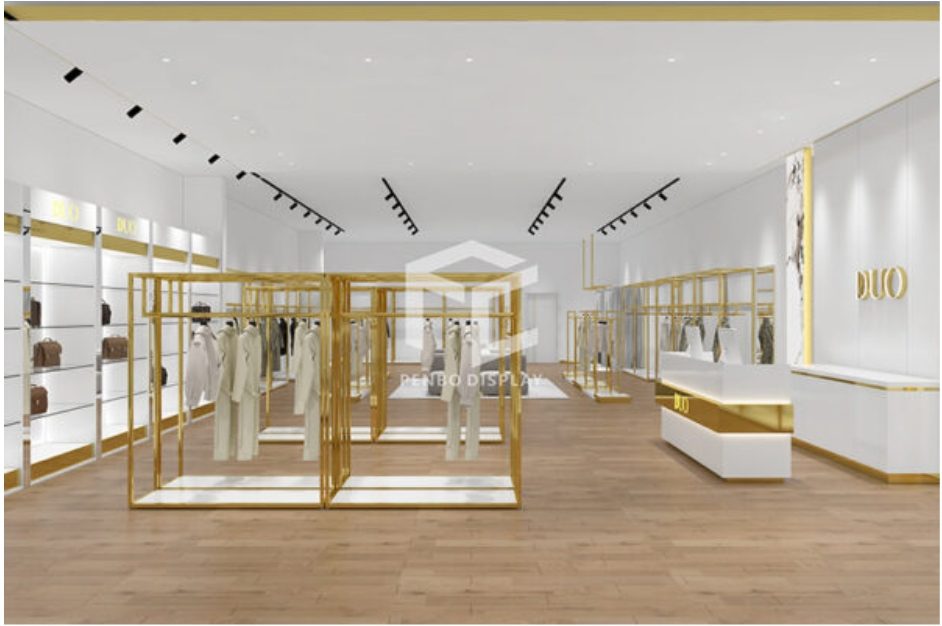Introduction to Clothing Store Furniture and Shop Fittings Suppliers:
Understanding the Importance of Store Layout: A clothes store’s layout has a important impact on how customers feel regarding it and what they decide to buy. A well-designed store makes the most of available space, promotes simple customer flow, and draws attention to imperative products.
Evolution of Store Design in the Retail Industry: Retail clothing store design has changed in excess of time in response to market changes, technology breakthroughs, as well as shifting consumer tastes. The goal of modern apparel stores is to create immersive spaces that interest customers’ attention and encourage brand loyalty.
Types of Clothing Store Furniture:
Display Racks and Shelving Systems: In order to present clothing merchandise in an orderly as well as visually pleasing way, these fixtures are essential. Wall-mounted racks, freestanding shelf, and movable displays are among the more than a few varieties.
Clothing Tables and Counters: Extra display area for folded clothing, trimmings, or promotional objects is offered by tables with counters. They may also be used as leave counters, which would get better the store’s general operation.
Fitting Rooms and Mirrors: Customers need fitting accommodation in order to try on clothes previous to making a purchase. Positive correct room design, with mirrors with soft lighting, enhances the business experience.
Shop Fittings for Clothing Stores:
Mannequins and Forms: Mannequins are used to in attendance clothing in a realistic way so that buyers be able to see how it resolve seem on them. Forms are used to make theme displays or to exhibit specific goods, such as clothing forms as well as body displays.
Signage and Branding Displays: Signage that is effective guides customers to various areas of the business, provides product information, in addition to strengthens brand identification. Brand memory and awareness are enhanced through branding displays, which include symbol signage and visuals.
Lighting Fixtures and Ambiance Creation: In order to make the right atmosphere and disposition in a clothes store, illumination is essential. Displays that are well-lit make crop easier to see, draw attention to important substance, and make clientele feel welcome.
Materials and Construction:
Wood, Metal, and Glass Options: Furniture and furniture for clothing stores come in a range of materials, each with unique sensible qualities and visual appeal. Metal delivers toughness with a contemporary look, while wood offers luxury and adaptability. Glass gives exhibits a suggestion of refinement and transparency.
Sustainable and Eco-Friendly Materials:
Reclaimed wood, recycled metal as well as low-emission coatings are among the sustainable capital that many merchants are using as a effect of rising consumer awareness of natural problems. In addition to decrease its negative belongings on the surroundings, eco-friendly furniture too draws in buyers who be concerned concerning the environment.
Customization and Personalization:
Customization options are provided by means of suppliers to enable furniture and fittings to be customized to the unique requirements and branding preferences of apparel businesses. Retailers may intend distinctive shop settings through customized fixtures to set their business at a distance from rivals.
Trends in Clothing Store Furniture:
Minimalist and Scandinavian Influences: Clean lines, muted hues, and neat areas are hallmarks of minimalist design, which is flattering more and more common in clothing store furniture. The stress of Scandinavian design, which is famous for its utility and simplicity, is on usual materials and subtle elegance.
Technology Integration in Store Fixtures: Retailers are civilizing the shopping experience as well as streamlining operations through integrating technology into store furniture. Digital signs, interactive displays, and inventory organization systems with RFID capability are a few examples.
Multi-functional and Space-Saving Designs: Multipurpose and compact furnishings designs are growing in favor as supermarket space becomes more constrained. Nesting tables, foldable racks, as well as convertible displays make the most of merchandising potential while maximizing room efficiency.
Customization and Bespoke Solutions:
Tailoring Fixtures to Brand Identity: Retailers may match their shop environment to their brand identity and positioning with the help of customized furniture and fittings. To offer a consistent brand experience, tailored fixtures might include design features, logos, and brand colors.
Collaborative Design Process with Suppliers: Retailers may benefit as of suppliers’ experience and industry knowledge through working together during the design process. In order to make best use of shop layout, fixture placement, as well as visual merchandising tactics, suppliers can supply insightful advice.
Prototyping and Testing: Custom fixtures can be tested as well as prototyped before going keen on full-scale manufacturing to assist find some usability problems or design defects. Retailers be able to offer suggestions and ask for changes toward make sure the finished goods complete their needs and expectations.
Installation and Maintenance:
Professional Installation Services: Many providers assurance that furniture and fittings are efficiently built and fitted by providing expert fitting services. Professional installers are ready with the knowledge and tools needed to do the setting up quickly and securely.
Maintenance Tips for Longevity:
Extending the life of fixtures with furnishings in clothing store furniture requires proper care. To maintain fixtures looking along with working at their best, suppliers may offer maintenance strategy and recommendations for regular cleaning, upkeep, and upkeep.
Upgrades and Renovations:
Retailers may need to bring up to date or remodel their shop fixtures over time in order to adapt to broken up consumer preferences or operational needs. Suppliers know how to help with creating new solutions to update the retail ambiance, replacing old components, or adapting existing fixtures.

Future Outlook and Innovations:
Virtual Reality in Store Design Planning:
Retailers may use virtual reality technology to see and replicate design concepts, fixture arrangements, and shop layouts in a virtual setting. During the shop planning process, executive, cooperation, and iteration are facilitated through VR-enabled intend tools.
Iot Integration for Smart Retail Environments: In retail settings, the Internet of Things (IoT) facilitate communication as well as data sharing between physical systems and strategy. Smart mirrors, interactive displays, and sensor-equipped shelving be examples of IoT-enabled fixtures that recover consumer interaction, bring together real-time data, and maximize ready efficiency.
Sustainable Practices in Manufacturing and Supply Chain:
In the retail separation, sustainable practices—such as by eco-friendly crop, energy-efficient produce techniques, and moral sourcing—are becoming more and additional crucial. To reduce their environmental effect and satisfy client insist for environmentally welcoming foodstuffs, suppliers are implementing sustainable practices next to each stage of the manufactured goods lifecycle, from the taking out of uncooked materials to the discarding of end-of-life items.


